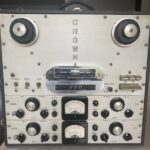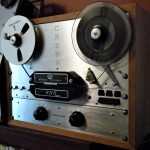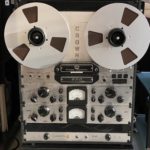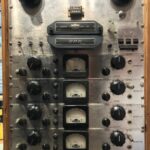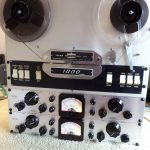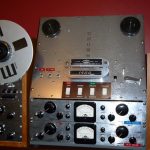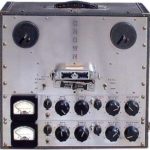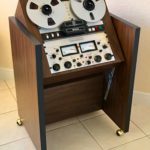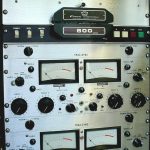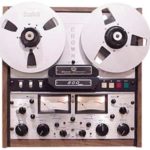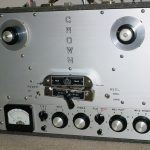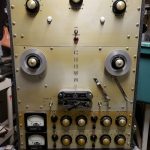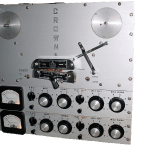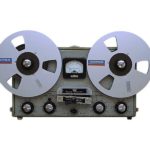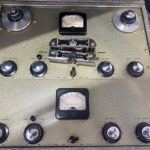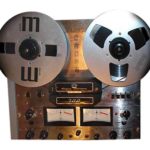In order to use this feature, you need register and become a member.
Already a member? Login Register hereCrown Reel to Reel Tape Recorders

1947 To Present
Company Description Submit New Info
Crown Reel to Reel History Clarence C. Moore (1904-1979) Built his first audio amplifier when he was a senior in high school. Known across the community as Loud Sound Clarence, he was a man with broad interests and knowledge, who earned a degree in math, music and english. He became a pastor and schoolteacher in Michigan. In the 1930’s, Clarence heard about a missionary organization in Ecuador that was having problems with their transmitter as a result of wild voltage swings. He had already solved similar problems on his farm where there was no electricity, having hooked up a generator to an old Model T. A visit to Ecuador resulted in him becoming pastor and chief engineer of Radio Station HCJB, now called Reach Beyond. His missionary work in South America continued for six years between 1939 and 1945.
He returned to Elkhart, Indiana and started consulting for a range of Christian organizations who were transmitting all over the US. One of the first consoles that he built was used by Billy Graham for his first radio message.
After the war, as new tape-recorder technology was developing in the US, he was approached by missionary with the idea of putting a tape recorder together with an amplifier for ease of field operation in Brazil and six weeks later the prototype was finished. Along the way, other people saw what he was doing and soon he had an order for six more and this is the founding story of International Radio and Electronics Corporation in 1947.
His son Clyde, the first employee, was given his first job, to clean out the 20×40′ foot building that was to be their new assembly area, that had previously been a chicken coop. Clarence and his talented wife Ruby began their foray into tape recorders studying and improving what few models of tape recorders were available by Magnecord, Recordio, Pentron and Crestwood. The intention was to make a more durable tape recorder suited to missionaries, who could use them in remote locations worldwide. In 1949 they patented the world’s first tape recorder with a built-in 15w amplifier, which hit the market in 1950. It was unique at the time to combine a mixer, an equalizer and a power amplifier into one product. This Integrated type of R-R tape recorder became quite popular with many manufacturers in the 50s and would continue to sell well into the early 60s.
The First Electronic braking was an early concept Clarence developed, as mechanical brakes often proved to be unreliable. One day after work Clarence approached one of his engineers asking – I know that AC voltage makes a motor run but what would happen if you put DC to the motor? The response was- it would make it stop. So that evening he set up an Experimental prototype which was demonstrated the next morning. By switching out AC and differentially putting DC on the back motor, switching through functions, the tape came to a smooth stop. Three motor Crown machines became the standard and this type of breaking was revolutionary at the time.
In 1959, Crown decided to produce a tube amplifier to sell separately and two Models were produced, the 30-30 & 15-15 which were often sold with tape recorders.
The name was changed to Crown international in the 60s, a name that was suggested by Ruby.
They continued producing tape recorders as their primary product and the manufacturing facility was increased to 20×80 feet followed a little later by 40 x 80 which would eventually double in size again in the late 60s.
Enter Clyde Moore In 1963, Clarence’s son Clyde had finished his engineering degree but his father saw greater potential and benefit to the company for him to go into sales. So, back to the University of Michigan Clyde went and brought home a stack of books on sales and marketing. They only had two sales reps at the time and these guys also sold other companies product, but with Crown, they had no rep agreements. Clyde decided to give these guys a much more fair agreement and compensation, where the reps were paid 21 days after shipping the product which was never done by their competitors. What followed is that some of the top sales reps in the business heard about this and they all wanted to work at Crown. He then went to work on the dealer agreement which was renewed annually and had the dealers committing to a program that ensured the customer’s support would be second to none. Very few companies other than Crown offered one year warranties at that time. Thanks to Clyde, Crown also had a way of keeping their employees really happy having a turnover rate of 7% which was extremely low.
Another son, Edwin C. Moore, worked for Crown while in college, as the sales manager, but left in 1963 to become the general manager of Christian ministry radio stations WCMR and WXAX in Elkhart as well as two stations in Fort Wayne.
1960- The beginning of studio quality recorders Crown designed and manufactured Tube-based tape recorders until mid 1964. The best ones can be identified from the serial number starting with C. Production of these started in late 1962. The B Decks that preceded them in 1960 were very good in their day, but suffered from a badly designed head assembly, where the removal of the headcover reveals the heads are attached to it. Very hard to align. Furthermore, the piano key function buttons which probably looked quite neat at the time, have potential for failure 60 years later. The Crown 1000, The rarest of them all (Only 2 known to exist now) also had this head assembly. Another super rare one, the 1400 (Only 2 known to exist) Came out a bit later, with the good head assembly of the C Deck.
The first really serious tube recorders and very likely the best sounding Crown machines ever made, are described as C Decks or transports. They are the early 800 Series and the serial number starts with C. Both the B & C tape recorders were paired with mono or 2x Mono =stereo, Tube electronics, model RP-3 which had three different iterations.
Introduced in August 1964, the SS-824, was their first solid-state machine and manufactured for two years.
The 700 and 800 Pro Series decks were the next evolution where the first 700 showed up in mid-late 1966 and the 800 in Late 1967.
Crown suffered a brief setback on Thanksgiving Day in 1971, when a fire destroyed over 60% of the factory and inventory. The company was underinsured and they were just completing another renovation. Unfortunately, the only building that did not catch fire was the one that they stored obsolete components and discontinued models in. Even though Crown had a pretty significant bank loan at that time, they also had a very large order that represented about three months of production and their banker suggested if Clyde could find a new building to resume production in, the bank would take care of the money side. With remarkable resilience, they were back up and running 6 weeks later, with many of the employees volunteering to work for free, during the transition.
The name changed once again in 1975, when the stockholders voted To change the corporate name to Crown International Inc.
In mid 1976, Crown began a serious study of the cassette market which was now beginning to hit full stride, comparing all the Higher End manufacturers specs & features in three price points to determine what would be needed in each, $700, $1000 & $1600. Solid competition for Nakamichi would be the primary goal.
Ultimately, they decided not to go into the cassette market.
With reel to reel tape recorder sales falling off fairly significantly, the decision was finally made to discontinue producing tape recorders in Dec. 1977 and the last SX822 was sold to Clarence Moore.
By law they were required to maintain parts inventory for seven years. After that, The tape recorder parts inventory, service manuals, card file of past clients and more was sold to John Haines (who had been working a Crown since the mid-60s and had become service manager)
This inventory was eventually transferred to Chuck Ziska, when John retired.
Continuing forward in amplifiers, tuners and various other audio products Crown started to shift their focus into professional audio. Don Eger started the Techron Division in 1981 marketing to industrial and OEM manufacturers.
They launched a completely new amplifier design with the PSA-2 which had built-in computer technology to maximize the output transistors performance. This Grounded Bridge circuitry was used in the Macro-Tech and Micro-Tech high-power amplifier products used in many high profile installations worldwide for PA systems and musical performance.
In the 1990s, Crown moved into computer-controlled audio systems, with an IQ system that they patented, the world’s first significant computer-controlled audio system. These systems were very versatile and can be used in small installations or for touring rock stars. At this point in time Crown equipment was a mainstay in public address and commercial sound systems known for its excellent sound and durability.
In 1997 they had yet another manufacturing expansion with many millions of dollars put into the effort and the next significant product was the K2 amplifier which had Balanced Current Amplifier circuitry offering benefits in thermal and energy efficiency.
The company was sold to Harman in the year 2000.
Crown reel to reel tape recorders are difficult to categorize on a website like this, as the company offered many options and their dealers were actively encouraged to make these available so many of the machines come in unique configurations that were not specific models. So many of the tape recorders below are representative of that…
Crown Reel to Reel Tape Recorder ModelsSubmit New Model
General Information Submit General Info
Manufacturer: Crown
Years in Business: 1947 To Present
Country: USA
Years making R-R Tape Recorders: 1949 To 1977
1963- 1964 Tube R-R Tape Recorders
701 Mono
702 1/2 tr mono
712 1/2 tr
714
714C Stereo
April 1965 – 1966 Solid State R-R Tape recorders
SS722
SS724
SS 800
September 1967 Pro 800 Series
CX-822 Serial# J3092 First sold in September 1967
Serial #’s started with J & K 3100-4300
Post-fire K 5000-7395
Available with either SX or CX electronics.
The CX was the better version with bass and treble controls, front bias control & 3 speed equalization where the SX is only two speed. You had your choice of which two speeds if you bought an SX.
The Final Crown R-R Tape Recorder
SX822 sold to Clarence Moore Serial# K7395 on 12/12/1977

